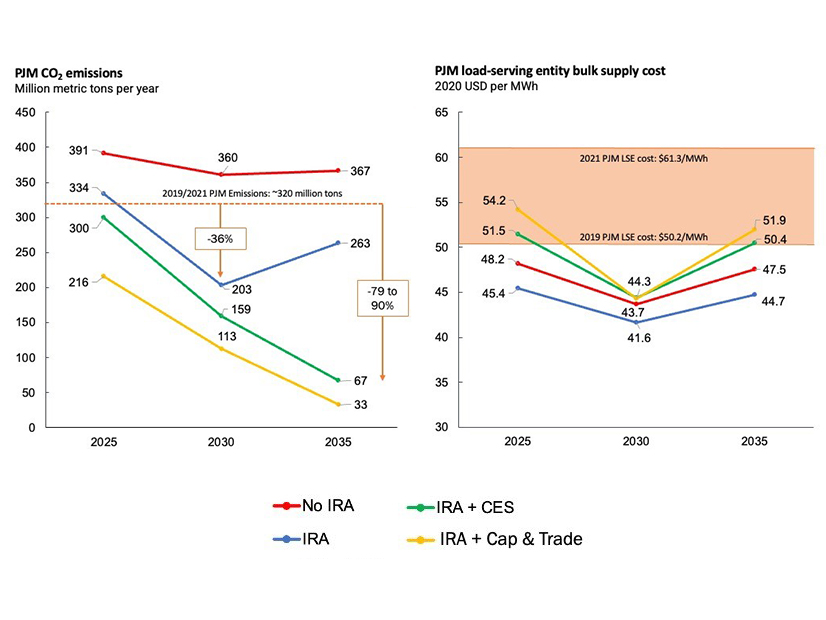
A new study projects that the Inflation Reduction Act will reduce PJM’s carbon emissions while delivering more affordable power.
“Passage of the Inflation Reduction Act this summer threw the full financial weight of the federal government behind the clean energy transition. As a result, CO2 emissions and electricity costs in the nation’s largest electricity market, the PJM Interconnection, will both decline sharply through 2030,” co-author and Princeton Assistant Professor Jesse Jenkins wrote in an email announcement of the study by Princeton’s Zero-carbon Energy Systems Research and Optimization Laboratory. He was joined by Qingyu Xu, Neha Patankar, Mike Lau, and Chuan Zhang in authoring the study.
Using GenX, an open-source optimization and planning model, the study assessed the law’s impact on energy prices, emissions and investments in the PJM grid from 2023 through 2035. The results suggest that carbon-free generation could make up 60% of the PJM supply in 2030, compared to 48% without the passage of the IRA.
With more clean energy coming onto the grid, the study estimated that CO2 emissions could fall 37% over 2019-21 levels, while without the law emissions would be expected to rise approximately 12%.
The study posits that these outcomes are made possible by the tax credits, grants, rebates and loans made available for carbon-free generation, vehicle and building electrification, energy efficiency and carbon capture and storage for natural gas facilities.
“The production tax credit for new carbon-free generation and the production tax credit [PTC] for existing nuclear are the most important provisions in terms of their aggregate impact on the evolution of PJM capacity, emissions and cost,” Jenkins told RTO Insider in an email. “The bulk of new capacity additions are wind and solar leveraging the PTC, and maintaining the substantial existing nuclear fleet across PJM provides a critical foundation for this new carbon-free generation to build on, rather than ‘run to stay in place’ and expend new renewable generation to replace existing carbon-free nuclear generation.”
This could be achieved, the study says, while achieving reductions in the cost of power by lowering wholesale rates, making it cheaper for states to meet their clean energy policy goals through subsidies, and growing electric demand to spread fixed costs.
“This study finds that, due to passage of IRA, the PJM region could cut CO2 emissions from power generation by 80-90% by 2035 while keeping average bulk electricity supply costs for [load serving entities] comparable to or lower than levels experienced in recent years,” the study says.
The study estimates the average 2030 cost for bulk energy for LSEs in the PJM region at $42/MWh — 5% to 10% lower than without the IRA. It notes that costs were $50.20/MWh in 2019 and around $61 in 2021.
The study identified several roadblocks to reaching the projections it made, as well as for maintaining them into the future.
States would have to make their own investments and policy changes to promote the deep decarbonization, for which the study contains a “cost-optimized blueprint.” The roadmap applies two policy constraints to the model to show the impact of a clean energy standard (CES) requiring increasingly carbon-free generation and a CO2 cap-and-trade system.
The CES modeling assumes that 55% of generation will be carbon-free by 2025, 70% by 2030, and 85% by 2035. The cap-and-trade program would have decreasing emissions relative to 2005 levels of 58% by 2025, 80% by 2030 and 95% by 2035.
The expiration of PTCs for nuclear generators could cause the gains made in emission reductions to backslide after 2032.
“Unless equivalent policy support is extended beyond 2032, our modeling finds 12 GW [0-33 GW] of the PJM nuclear fleet is likely to retire by 2035, with new natural gas capacity and generation increasing to fill the resulting gap and meet growing demand, reversing some of the emissions progress achieved through 2030,” the study said.
Independent Market Monitor Jo Bowring said he believes the study includes both optimistic assumptions and outcomes regarding energy demand, prices and the penetration of intermittent resources into the PJM market.
“It’s obviously a very optimistic view of cleaner, faster and cheaper,” he said.
Bowring also noted that the third quarter State of the Market Report calculated the revenue received by nuclear generators over their avoidable costs and found that the resource type is profitable, including under laws such as Illinois’ Climate & Equitable Jobs Act, which he said eliminates the need for additional subsidies to keep the resource competitive.
He also questioned whether the scale of intermittent development is realistic given the low penetration currently seen in PJM and said the study’s LMP estimates for 2025 — which range from the mid $20’s/MWh to the low $50’s — are optimistic given that PJM has been in the $70/MWh range in 2022.
Jenkins said the IRA “fundamentally changes the economics of decarbonization across PJM,” however it will take an acceleration in renewables coming online for the full potential of the law to be seen.
“However, realizing that full potential — including both savings for electricity customers and reductions in CO2 emissions — will require accelerating the rate of renewable energy deployment and, in particular, grid interconnection, relative to recent trends in PJM. That’s a challenge the region as a whole already had a lot of reasons to proactively tackle, and the Inflation Reduction Act gives PJM stakeholders millions (of dollars in savings and avoided emissions) more reasons to do so,” he said.



